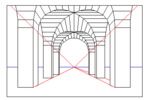Vanishing point
From Wikipedia, the free encyclopedia
| Please help improve this article or section by expanding it. Further information might be found on the talk page. (November 2008) |
| This article does not cite any references or sources. Please help improve this article by adding citations to reliable sources (ideally, using inline citations). Unsourced material may be challenged and removed. (March 2008) |
 |
| Part of a series on: |
| Graphical projection |
A vanishing point is a point in a perspective drawing to which parallel lines appear to converge. The number and placement of the vanishing points determines which perspective technique is being used.
- linear perspective is a drawing with 1-3 vanishing points.
- curvilinear perspective is a drawing with 5 vanishing points mapped into a circle with 4 VPs at the cardinal headings N,W,S,E and one at the circle origin.
- reverse perspective is a drawing with vanishing points that are placed outside the painting with the illusion that they are "in front of" the painting.
Vanishing points were first used by Renaissance artists such as Donatello and Masaccio.
Vanishing points can also refer to the point in the distance where the two verges of a road appear to converge. This is often used to help assess the upcoming curves in the road; to judge the radius and therefore the entry speed and optimum line. If the vanishing point moves towards you or to your sides, the curve is tightening. If the vanishing point moves away from you or comes to center, the curve is straightening.
|
A people mover at Frankfurt International Airport illustrating the vanishing point at the end of the tunnel. |
Pietro Perugino's usage of perspective in this fresco at the Sistine Chapel (1481–82) helped bring the Renaissance to Rome. |




